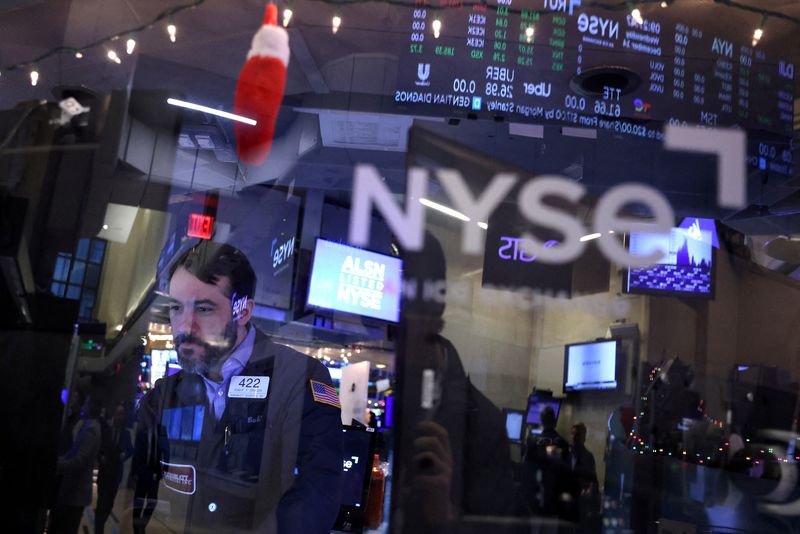By Echo Wang
(Reuters) - U.S. stocks closed out 2022 lower on Friday, capping a year of sharp losses driven by aggressive interest rate hikes to curb inflation, recession fears, the Russia-Ukraine war and rising concerns over COVID cases in China.
Wall Street's three main indexes booked their first yearly drop since 2018 as an era of loose monetary policy ended with the Federal Reserve's fastest pace of rate hikes since the 1980s.
The benchmark S&P 500 has shed 19.4% this year, marking a roughly $8 trillion decline in market cap. The tech-heavy Nasdaq is down 33.1%, while the Dow Jones Industrial Average has fallen 8.9%.
The annual percentage declines for all three indexes were the biggest since the 2008 financial crisis, largely driven by a rout in growth shares as concerns over Fed's rapid interest rate hikes boost U.S. Treasury yields.
"The primary macro reasons ... came from a combination of events: the ongoing supply chain disruption that started in 2020, the spike in inflation, the tardiness of the Fed beginning its rate tightening program in the attempt to corral the inflation," said Sam Stovall, chief investment strategist at CFRA Research.
He also cited economic indicators pointing to recession, geopolitical tensions including the Ukraine war, and China's surging COVID cases and uncertainties over Taiwan.
Growth stocks have been under pressure from rising yields for much of 2022 and have underperformed their economically linked value peers, reversing a trend that had lasted for much of the past decade.
Apple Inc (NASDAQ:AAPL), Alphabet (NASDAQ:GOOGL) Inc, Microsoft Corp (NASDAQ:MSFT), Nvidia Corp, Amazon.com Inc (NASDAQ:AMZN), Tesla (NASDAQ:TSLA) Inc are among the worst drags on the S&P 500 growth index, down between 28% and 66% in 2022.
The S&P 500 growth index has fallen about 30.1% this year, while the value index is down 7.4%, with investors preferring high dividend-yielding sectors with steady earnings such as energy.
Energy has recorded stellar annual gains of 59% as oil prices surged.
Ten of the 11 S&P sector indexes dropped on Friday, led by real estate and utilities.
"The housing market has really slowed down and the values of people's homes have declined off of the highs earlier this year," said J. Bryant Evans, investment advisor and portfolio manager at Cozad Asset Management in Champaign, Illinois.
"That affects people's mind frame and actually affects their spending a little bit."
The focus has shifted to the 2023 corporate earnings outlook, with growing concerns about the likelihood of a recession.
Still, signs of U.S. economic resilience have fueled worries that rates could remain higher, though easing inflationary pressures have raised hopes of dialed-down rate hikes.
Money market participants see 65% odds of a 25-basis-point hike in the Fed's February meeting, with rates expected to peak at 4.97% by mid-2023.
The Dow Jones Industrial Average fell 73.55 points, or 0.22%, to 33,147.25; the S&P 500 lost 9.78 points, or 0.25%, at 3,839.50; and the Nasdaq Composite dropped 11.61 points, or 0.11%, to 10,466.48.
Volume on U.S. exchanges was 8.50 billion shares, compared with the 10.79 billion average for the full session over the last 20 trading days.

Declining issues outnumbered advancers on the NYSE by a 1.50-to-1 ratio; on Nasdaq, a 1.03-to-1 ratio favored decliners.
The S&P 500 posted no new 52-week highs and no new lows; the Nasdaq Composite recorded 85 new highs and 134 new lows.